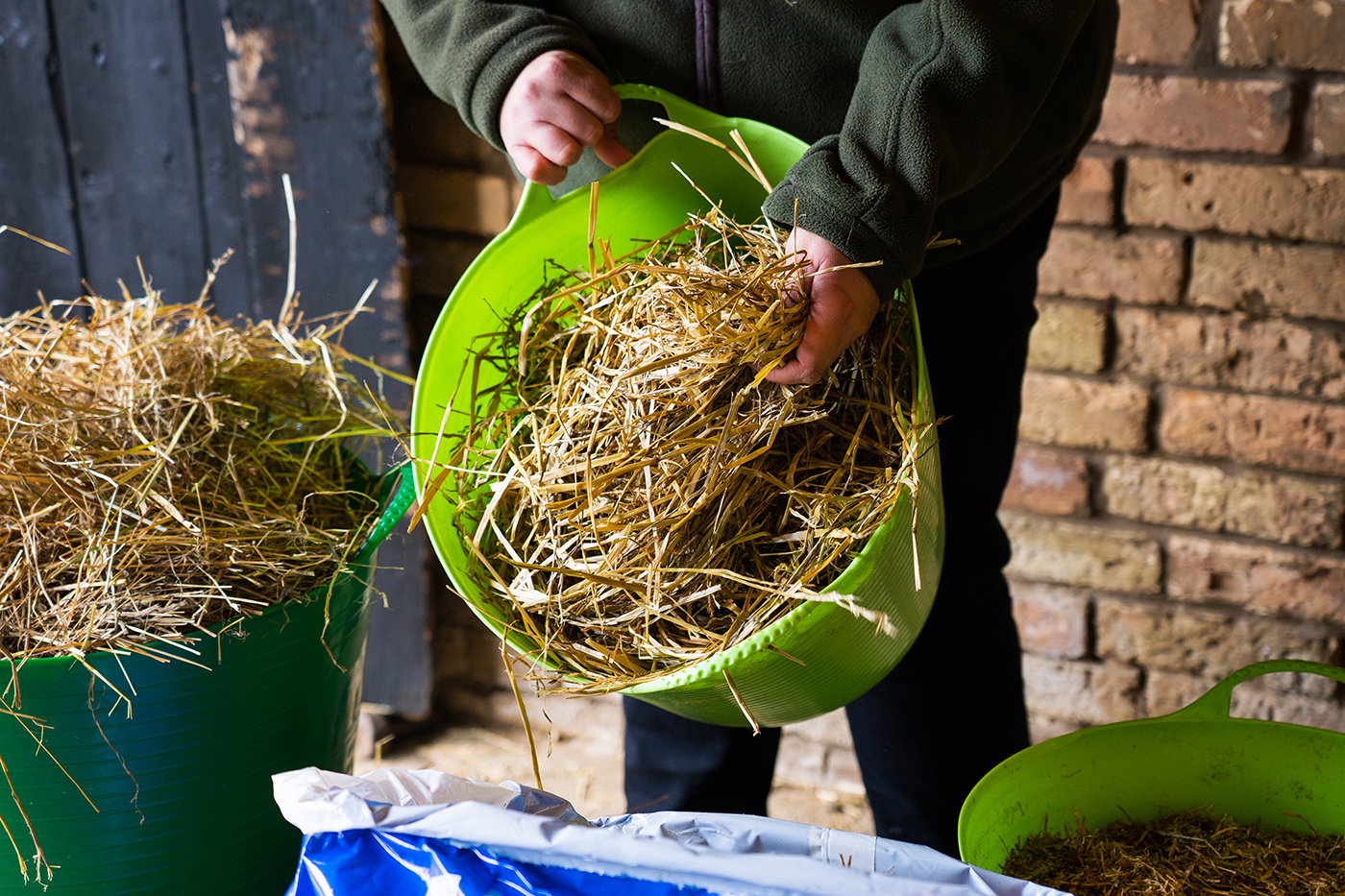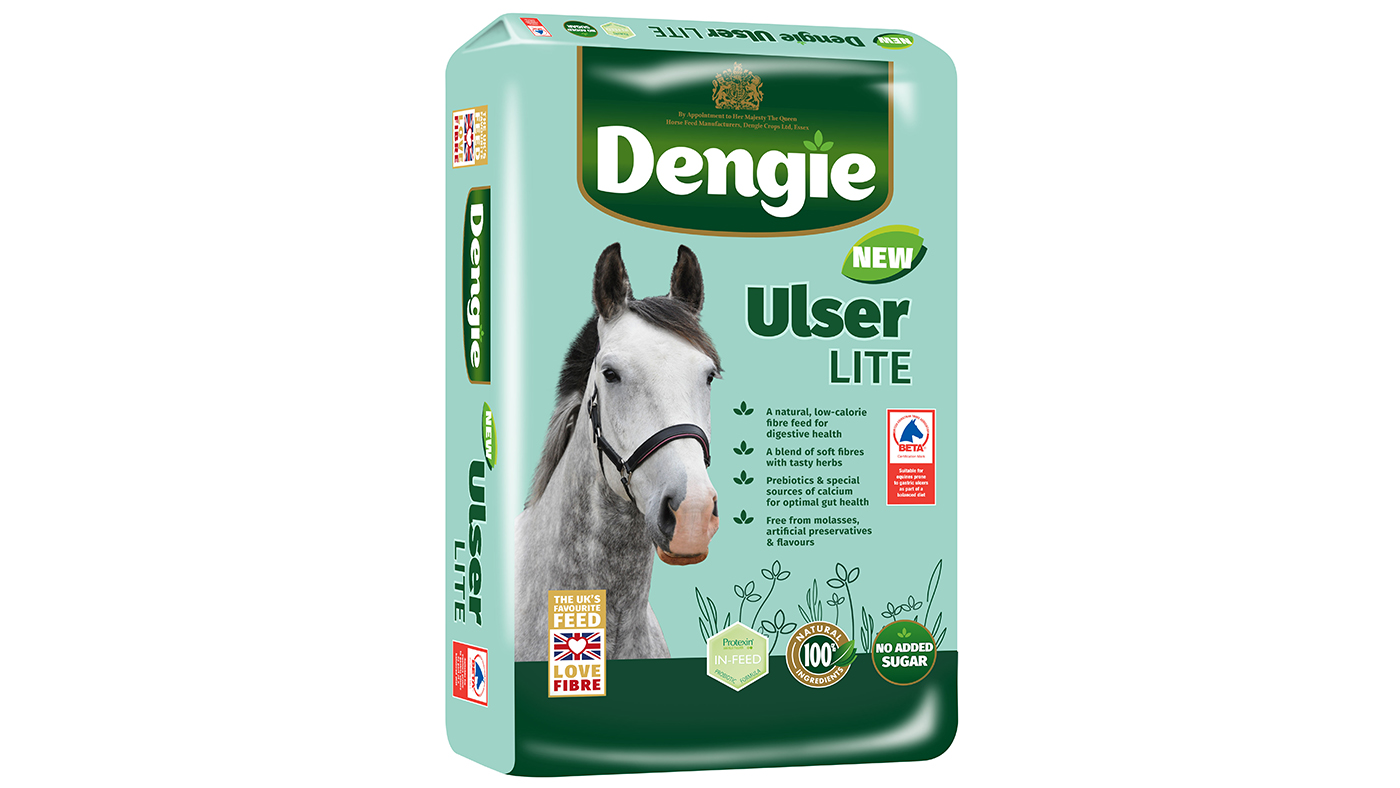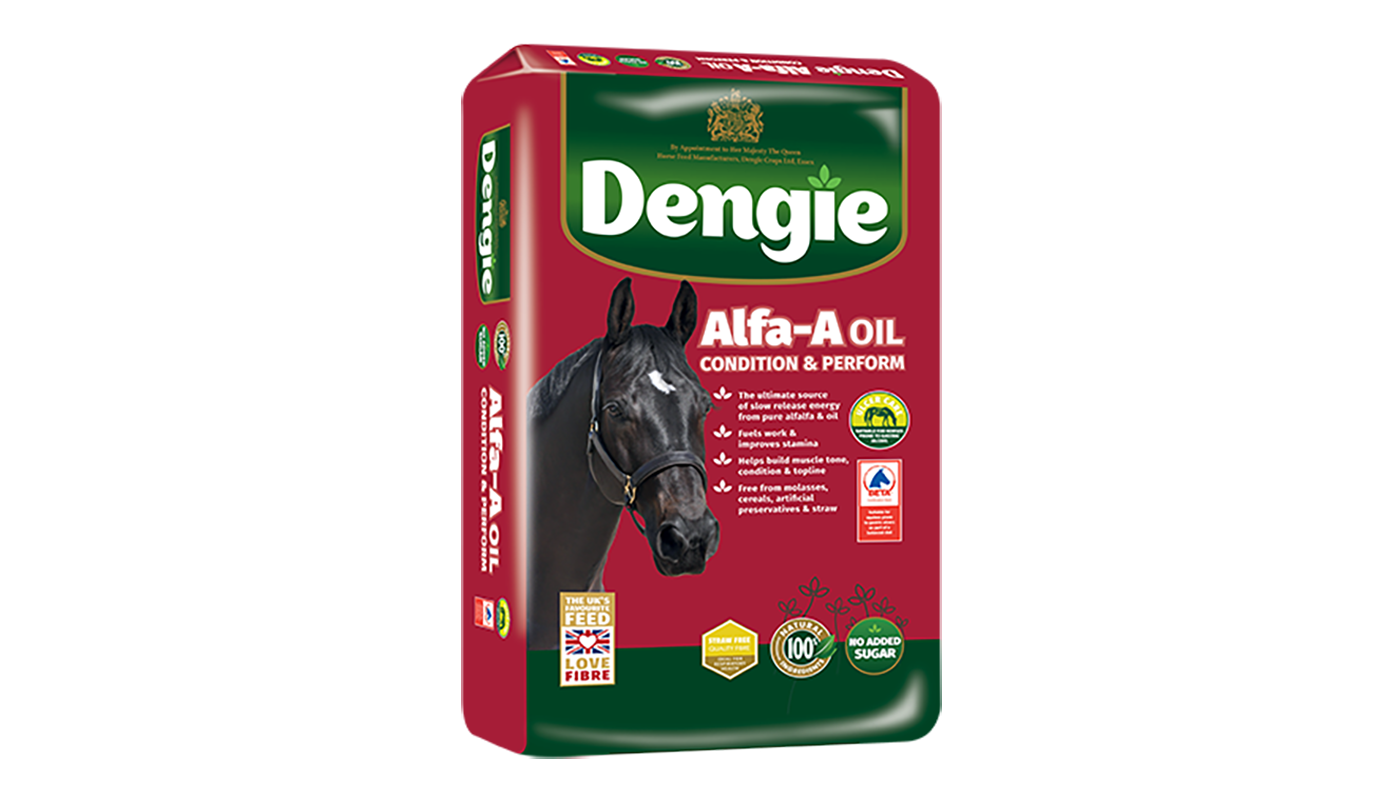Promotional Feature with Dengie
Understanding of equine gastric ulcer syndrome (EGUS) has evolved over the past 30 years to the point that it is now known any horse could have ulcers and it is not a disease confined to the classic underweight horse in poor condition.
In fact, one study has shown that only half the horses visiting a Belgian equine hospital for ulcer treatment were underweight. There also appears to be no link between the severity of ulcers and the signs – some horses are clearly very stoic and can have grade four ulcers with no obvious clinical signs at all.
As a result, and because it generally makes good sense to do so, advice for feeding all horses today is to keep levels of starch low and use high fibre diets as much as possible.
But what does this mean in practice? Dengie answers some FAQs on feeding horses to reduce the risk of ulcers.

International five-star event rider Alex Bragg says: “Alfa-A Oil is an essential element for all of our horse’s diets. I know a happy, healthy horse can give 100% in both training and competition.”
1. How low is a low starch diet?
The level of starch generally recommended is 2g/kg bodyweight (BW) per day or 1g/kg BW per meal as a study showed that feeding above these levels more than doubled the risk of a horse having ulcers.
Cereal-based mixes and cubes can vary considerably in the amount of starch they provide and range from around 10% to as high as 30%. A producer of a feed containing 10% starch could therefore claim that their feed is low starch when it is compared to other cereal-based feeds.
The table below shows the difference in starch levels between Alfa-A Oil and a cereal-based feed with the same level of energy per kg. Dengie Alfa-A Oil can rightly claim to be much lower in starch than even the “low” starch cereal mix – five times lower!
The other factor to consider is the amount being fed. The table below shows how feeds with the same starch content, but different feeding rates, can also provide very different levels of starch in the ration.
This means it is important to consider both the level of starch and the amount fed.

International dressage rider and trainer Hannah Esberger-Hancock says: “Alfa-A Oil is perfect for my horses; I wouldn’t feed anything else.”
2. How much forage should I feed my good-doer with ulcers?
The increasing frequency with which ulcers is being diagnosed may account for why the recommendations for minimal dry matter intake tend to increase in more recent studies. The consensus among most vets and nutritionists for the long term management of good-doers is 1.5% of current bodyweight on a dry matter basis.
Dengie breaks this down a little bit more:
- 1.5% – earlier studies have gone as low as 1% of bodyweight and while no adverse effects on welfare of the horses were found, the study didn’t look for ulcers and lasted 12 weeks.
- Current bodyweight – we advocate using the horse’s current bodyweight as it is less subjective than trying to estimate what the horse’s ideal bodyweight should be. If the weight loss programme works, then the intake required will gradually reduce in line with the horse’s weight loss. A gradual reduction in intake is a much safer approach to maintaining digestive health than one big drop.
- On a dry matter basis – wetter forages such as haylage may only contain 60% dry matter, whereas hay is around 85% dry matter. If recommendations are given on an as-fed basis, a horse receiving haylage will be consuming much less fibre than the horse on hay, as 40% of what is consumed is water. If trying to calculate how much forage your horse can have on a dry matter basis is confusing please don’t be embarrassed to ask for help – our nutritionists will do this for you so you know you are using the right amount.
- Long term management – to deal with an acute significant obesity or laminitis situation it may be necessary to reduce to below 1.5% for three to six months for example. The aim would always be to return to at least 1.5% as soon as possible to reduce the risk of other health issues such as ulcers.
The key take-home message here is: use a lower energy forage or low-calorie forage replacer such as Dengie Hi-Fi Lite or Dengie Ulser Lite, so that more can be fed without promoting weight gain, rather than reducing to below 1.5%

3. Can I feed straw to a horse with ulcers?
One way to manage forages that are higher in energy or sugar is to mix them with straw. Sadly, misinformation about straw puts some people off using it, especially for those with ulcers.
In 2009, a study that looked at the incidence of gastric ulceration in a population of horses found that those that were fed straw as the sole or predominant fibre source were more likely to have ulcers. However, the key here is that straw was used as the sole or predominant fibre source, which is not typically done in the UK.
Recognising that straw can be useful as a low-calorie forage source for good doers, a follow-up study has been published investigating the safety of feeding 50% wheat straw to replace haylage. The study found no ill effects and specifically looked for gastric ulcers indicating straw could be a really useful ingredient in the fight against ulcers and weight gain!
Following this study, Dengie has done some simple calculations that show that if straw is used to replace one third of the weight of an average haynet, a reduction in energy intake of 16% is achieved. If half of a good quality haylage haynet is replaced with straw, the overall reduction in energy is around 25%. These are really significant reductions that could make all the difference to managing a good doer to avoid ulcers and is also why Dengie uses straw as an ingredient in its range of low-calorie feeds such as Dengie Hi-Fi Molasses Free, Dengie Hi-Fi Lite and Dengie Ulser Lite.

4. Can I use haylage for a horse with ulcers?
The concern about using a true haylage for horses with ulcers is that the fermentation process used to conserve the forage produces acids. It is logical not to feed a forage that has increased levels of acidity to a horse with an issue related to increased exposure to acid. However, a more accurate description of many so-called haylages would be wrapped hay as they are often very dry, which has meant that little or no fermentation has occurred. This means the levels of acidity are no different to a normal hay which can be seen in the table below.
A comparison of different forages:

A possible benefit of using wrapped hay is that it may well have been harvested earlier and so is likely to be more digestible, meaning that the horse will do better on it. Forages containing more moisture and cut earlier are often softer and so may be easier for horses with ulcers to manage. They are often more palatable, which is useful for poorer doers who may not have a big appetite.

BS Accredited UKCC Level 3 trainer Jo Burns-Firth says: “Ulser Lite is ideal for my horses, it helps me manage their weight, they have plenty of energy and are performing the best they ever have!”
5. Can I use alfalfa for horses with ulcers?
The simple answer is yes, you can. Studies back in the early 2000s showed that alfalfa was more beneficial for horses with ulcers (ESGD) compared to grass forages, as the high levels of calcium and magnesium it contains act as natural buffers to acidity. Alfalfa has really deep roots – about three to four metres – and the calcium at this depth in the soil is more available for absorption. This means that alfalfa plants can take up more calcium than grass – chopped alfalfa contains between 30 and 50% more calcium than grass forages.
So why are some people concerned about feeding alfalfa?
There has also been a study published that has caused confusion about the use of alfalfa. It explored the incidence of ulcers in foals and scoped them just after weaning. The researchers found that foals fed chopped alfalfa had a higher incidence of equine glandular gastric disease (EGGD) than those fed alfalfa pellets or hay. However, it is important to consider that this was a very small study using weaned foals.
Weaning is a very stressful time and stress is known to be a significant contributing factor to EGGD and so while there may be correlation in this study, it definitely doesn’t confirm causation.
The same research group have subsequently published other studies comparing grass and alfalfa hay in adult horses. The horse with ulcers at the start of the study no longer had ulcers after being fed the alfalfa hay, suggesting there was some protective effect from alfalfa, as has been seen in other studies.

Dressage rider and trainer Anna Miller says: “Performance Fibre is the best feed for my fit, fussy performance horses while also soft and easy to chew, and is therefore ideal for the youngsters too.”
Dengie has a range of feeds that utilise the benefits of alfalfa for horses prone to EGUS, four of which are independently approved with the BETA approval mark.
Ulser Lite
A soft blend of high-quality oat straw with chopped and pelleted British grown grass and tasty herbs for maximum chew time with minimal calories. Ideal for good-doers that are prone to gastric ulcers. Includes ADM Protexin In-Feed Formula, which supplies prebiotics for optimal digestive health.
Healthy Tummy
A nutritionally-balanced, pure alfalfa, conditioning feed with a high-specification of vitamins and minerals. Includes B vitamins, plus addition magnesium and calcium for optimal digestive health and ADM Protexin In-Feed Formula supplies prebiotics to promote a healthy gut microbial population
Alfa-A Oil
A high-calorie blend of pure alfalfa with rapeseed oil supplying 12.5%MJ/kg of digestible energy, which is comparable to a conditioning mix or cube. Naturally low in starch at just 2% and naturally occurring sugar at just 4.5%. Ideal for fuelling work, promoting condition and weight gain.
Performance Fibre
A blend of soft, easy to chew, highly digestible fibres – alfalfa and grass – with a high level of rapeseed oil. A light molasses and spearmint oil coating encourages fit, fussy performance horses to eat up.
For further support on feeding your ulcer-prone horse or pony and for any other feeding queries speak to a Dengie nutritionist on 01621 841188 or for a personalised diet plan complete Dengie’s feed advice form. Discover more at www.dengie.com
Research references
Bäuerlein V., Sabban C., Venner M., Vervuert I. (2019) Effects of feeding alfalfa hay in comparison to meadow hay on the gastric mucosa in adult Warmblood horses. Pferdeheilkunde 36, 29–36; DOI 10.21836/PEM20200105
Galinelli N, Wambacq W, Broeckx BJG, Hesta M. High intake of sugars and starch, low number of meals and low roughage intake are associated with Equine Gastric Ulcer Syndrome in a Belgian cohort. J Anim Physiol Anim Nutr. 2019;00:1–6. doi.org/10.1111/jpn.13215 AJVR, Vol 63, No. 11, November 2002
Hilyer et al (1997) A cross-sectional study of colic in horses on thoroughbred training premises in the British Isles in 1997
Jansson and Lindberg (2012) A forage-only diet alters the metabolic response of horses in training
Jansson et al (2021) Straw as an Alternative to Grass Forage in Horses—Effects on Post-Prandial Metabolic Profile, Energy Intake, Behaviour and Gastric Ulceration, Animals. Doi. 10.3390/ani11082197
Luthersson, N., Hou Nielsen, K., Harris, P., & Parkin, T. D. H. (2009). Risk factors associated with equine gastric ulceration syndrome (EGUS) in 201 horses in Denmark. Equine Veterinary Journal, 41(7), 625–630. https://beva.onlinelibrary.wiley.com/doi/abs/10.2746/042516409X441929
Luthersson et al (2019) Effect of Changing Diet on Gastric Ulceration in Exercising Horses and Ponies After Cessation of Omeprazole Treatment. Journal of Equine Veterinary Science
Lybbert et al (2007) Proceedings of Annual Convention of the AAEP, Orlando, Florida, 2007.
Swanhall et al (2018) Mineral and Vitamin Supplementation Including Marine-Derived Calcium Increases Bone Density in Thoroughbreds. Proceedings of the Australasian Equine Science Symposium









